 |
 |
 |
|
|||
|
Cambodia: Haunted by History I came to my office late at night and the offer was on my phone machine: four days in Cambodia, all expenses paid, in exchange for a story. The sponsor and host was the very famous Raffles International hotel company, which I had never heard of. Could I leave in two days? I glanced at my Union Pacific appointment calendar, blank for the entire month. One day getting there, one day getting back...about a week altogether, no problem. What I knew of Cambodia was this: We bombed it, pretty bad, during the Vietnam War, and then there was a communist revolution where one, maybe two million people died. But that was 20 years ago, it might be a very nice place by now. I called back and said my bag was already packed. There were five of us, all except for myself professional travel writers from such publications as Town and Country and National Geographic Traveler. We flew business class on a 747, lots of leg room and private televisions that came up out of the arm rests; wine and alcohol and exotic fruit juices, salmon and lobster; and, my favorite, hot towels for my hands and face. It took 20 hours, with a stop in Tokyo, so I had time to read up a bit on the hotel company and Cambodia.
Just as the millions and millions of dollars of renovations in both hotels were being completed, the Cambodian government went to war with itself. There were tanks squaring off in the streets shooting at each other, bomb holes in the airport, blood spattered on the walls of the terminal building. Tourists and foreign aid officials couldn't get out of the country fast enough. They fled in C-1 transport planes brought in by the Thai airforce. Since then, tourism in Cambodia has dwindled to a small number of young European, Japanese and American backpackers with no where near enough money to stay at a Raffles hotel. We were met at the airport in Phnom Penh by the manager of the Hotel Le Royal, a suave British expatriate with an expensive suit and perfect hair, and we rode into town in a BMW limousine. Phnom Penh is mainly two- and three- story buildings, with shops on the lower level that open to the streets, which are covered with a thick pad of light, brown dirt. I asked the manager what the political situation was like in the country now, whether there was still a civil war going on, and he said that the country was remarkably calm and stable. He said there had been a perceived negativism in the press lately, which, he said, "has been regrettable and unfortunate," and that the city itself hasn't been as peaceful and safe in a long time, "which is very encouraging, very encouraging."
I was supposed to go to lunch and then tour Le Royal with the group, but I was uncomfortable being led around by the nose, so I left, and for 15 cents got in a cyclo headed south down Monivong Blvd. A cyclo is a goofy tricycle rickshaw taxi where you sit in an open one-seat buggy down low to the ground and hang your feet out in front to the oncoming traffic, which is continuous and coming on both sides -- cyclos and motorcycles in whole schools like fish, cars and trucks marauding about pretty much at will as the only traffic rule seems to be that the bigger vehicle has right of way. There's no question of whether you drive in the left or the right lane -- in Cambodia there is just the road, which is like a river that flows in two directions at once. I had the driver pull over at Lucky Lucky Motorcycle Rentals, where I spoke to Mr. Lucky. He recommended that I take a 250cc dirt bike and I agreed. Seven dollars a day and I would have to leave my passport. I asked him if it would be okay with him if I rode the bike up Highway 6 to the Angkor temples, a distance that I figured to be around 200 miles. Mr. Lucky said yes but that I should watch for police and military personnel and to not stop for them under any circumstances, that I should ride away from them as quickly as possible. I gave Mr. Lucky my passport and rode out into the river of traffic. My plan was to get away from the hotel tour and travel through the countryside, where 90 percent of Cambodians actually live. But Mr. Lucky had worried me, so I made my way across town to the office of the United Nations Development Program and asked to speak to the security officer.
He said that there were basically three towns that were safe for tourists -- Phnom Penh, Siem Reap near the temples, and Sihanookville on the southern coast -- but that tourists should not travel by road or train, but instead to fly in and out of each town. He said that the countryside, the jungle, was ruled not only by the Khmer Rouge but other rival factions as well and that they all had guns, a lot of guns, and that if you're a foreigner they figure that the ransom will be very high. Or, they'll just kill you for the motorcycle alone. He said that I should be careful and alert to such things as if for instance all of sudden the traffic stops and the road is empty. That this would mean something was wrong. Then he said that he would like to visit with me some more but that as it was five o'clock, he would be leaving and that maybe I should go talk to the journalists who hang out at the Foreign Correspondents Club, a bar along the Mekong River. The club was on the second floor of a building facing the confluence of the Tonle Sap and Mekong Rivers. The wall towards the river was open floor to ceiling, and there was a tiled veranda looking out over the water. The place smelled of beer and marijuana, which is not exactly legal but somewhat tolerated in Cambodia. It was a great view, a great bar. I asked the bartender for a beer and whether there were any journalists in the house and he made a sweeping gesture with his arm as if to say they were all journalists. Then I asked him for the best journalist and he pointed to a man sitting in an armchair holding court with six or seven others. I went over and introduced myself and plead first for mercy in the face of my ignorance and then boldly asked for a briefing. I have used this tactic in bars in Nevada and Wyoming only to have met with the gravest of consequences, but, praise Jesus, in Phnom Penh it worked and I was taken in by Ed Fitzgerald, correspondent for the Asia Business News and also CNBC's Asia Report. He was drinking apple juice and smoking cigarettes. I drank beer and smoked his friend's marijuana and got generally overwhelmed as he laid out the basic scenario. In Cambodia, he said, one out of ten babies die at birth. In Cambodia, one out of five children die before the age of five. Sixty percent of the people here are under the age of 26. This is a country, the size of the state of Missouri, on which the U.S. dropped 600,000 tons of bombs from 1969 to 1973. This is a country that then went through a communist revolution where 1.5 million people were tortured and murdered or died from starvation and disease, a country where now there are less than 10 million alive, but more than ten million land mines still in the ground. "I know thousands of amputees." he said, "Thousands." I was speechless and wanted to go out on the veranda for some air and maybe look at the river for a while, but Fitzgerald wasn't through. "I think you should encourage people to come here," he said. "Tourism is a good thing for Cambodia; it brings in dollars and it brings in people who see how things are and then go home and talk about it, and it is, after all, a very beautiful country. The people, after all they've been through, are warm, even passionate, and very friendly to tourists. I think you should tell people to come here but that they should be smart about it. Don't come to Cambodia and rent a motorcycle and head off down the highway. This is not a country for the unwary. This is not Tahiti; this is not Bali. You can die here. If not by being taken hostage and shot, then just by stepping off the road to take a leak."
The next day I had a hangover and I stuck with the group. We went first to the Royal Palace, but nobody was home. Then we went to a Christian mission that was running a handicraft center, which employed handicapped people, mostly kids who'd been hit by land mines. They showed us how they make baskets, even a 13-year old boy who'd had his eyes blown out and the skin sewn shut in a big X over each eye socket, like in a cartoon. They played a song for us, a young boy with one arm playing the drum, a girl missing a foot on the Cambodian tror. After lunch we had a choice: we could either a.) relax at the spa and have a massage; b.) visit a famous artist's studio, or c.) go on a tour of the killing fields. Three of us, the three men, chose the killing fields, which is actually just one of many, many killing fields in Cambodia. This particular one is only 14 miles from town, and they've made it into a memorial park.
But first we stopped at the Toul Sleng Prison, still in Phnom Penh. Before Pol Pot and the Khmer Rouge took over in 1975, the prison was a junior high school. In the three years of terror by Khmer Rouge, over 14,000 men, women and children were brought here. Only seven people are known to have gotten out alive.
The classrooms were very small, cement and cinder block, and each room was empty and clean except for a metal bed in the center of the floor, and one black and white poster-sized photograph hanging one the wall. Each photograph was a documentary record taken by the Khmer Rouge authorities of a prisoner lying chained to the metal bed and he looked blackened and charred, like an over-cooked hotdog. He had been electrocuted, wires attached to the bed frame, and shocked again and again. In another room there was another bed with a collapsible army shovel lying next to it on the floor. The photo on the wall showed a man on the bed and the shovel lying next to the bed. It took a minute of study before I realized that the man's face had been scooped off his head, and the tour guide said that the shovel was used to do this. He explained that he prisoners were killed not by bullets or gas, but by using farm tools such as shovels and picks and so on. In another building were hundreds, thousands of photographs of the prisoners, all with numbers on their chests and their hands tied behind their back. Also, there were photographs of the guards and executioners, and as I looked at these photos I realized that a lot of them were just kids, the same age as the kids who would have gone here to school -- that the torturers and killers had been children. This is when I admitted I was playing way out of my league, that I was being given way more than I was able to take, and I just sort of shut down and started crying. Back in the bus all three of us were in favor of skipping the visit to the killing fields. We were tired, we said. We wanted to go back to the hotel. Our young Cambodian guide assured us that we could be there and back in an hour and a half. He was worried that we were not enjoying the tour, that as travel writers we would not encourage others to take the tour, that somehow something had gone terribly wrong, and he was right. On the way back, I asked him if he had lost friends and family during the Pol Pot era, and he said yes, both of his parents and many other relatives. And then, he made a sweeping motion with his arm, the same motion as the bartender had made, only the tour guide was motioning out to the mass of traffic on Monivong Blvd, and he said, "Everybody lost members of their family, all of us." I wasn't feeling well. I was sick at dinner, a formal dinner with coats and ties and invited guests from the Cambodian Ministry of Tourism, $80 bottles of wine, roast duck and caviar. Who knows, I saw none of it, as I had to excuse myself and go throw up in my wall to wall marble bathroom. "Ghostbusters 2" was on the TV again. I watched the film lying in bed sweating and shaking through one of the most intense, bone aching fevers I've ever had in my life. In the film, the ghosts from the River of Slime were haunting New York City and causing people to act mean and crazy. But the Ghostbusters, by using their amazingly powerful proton blaster guns, were able to contain and dispose of the ghosts and everyone in New York was happy and nice to each other again. And, miraculously, by the end of the film my fever had broken and I fell asleep, cured no doubt by the proton blaster guns. The next morning I flew with the others from Phnom Penh to Siem Reap for a two-day tour of the ancient Angkor temples. I had given up on riding the motorcycle through the countryside, and wanted only to rest in Siem Reap, smell the flowers in the lobby, maybe let the waiter unfold my napkin for me. Siem Reap is a small town alongside a small river in the jungle. The countryside is mainly flat, blocked out fields of dry brown dirt and dry brown grass, some water buffaloes waiting for the monsoon. The people, even in town, live in wooden huts elevated one floor off the ground and restaurants and shops to accommodate the tourists who come to see the ruins, three miles to the north.
At the center of the most famous temple, Angkor Wat, is a shrine representing Mt. Meru, the home of Vishnu, the sustainer of the universe and all of creation. Here there were depictions of Vishnu riding his garuda, and of Vishnu lying on a snake, a sacred naga, floating in the sea of milk while Brahma creates the universe. From this center the temple radiates out in concentric squares, involving mystical combinations, sort of Pythagorean and platonic, magical numbers and pure forms. They had it all mapped out and set in stone. I walked back out and was standing on the main causeway going into the center shrine. The causeway is several hundred yards long, like a long stone bridge over a moat a kilometer long on each side. I was with a bunch of kids who skip school every day and hang out at the temples to con money out of friendly tourists. Some can speak English as well as German, Japanese and French, and one of the kids was saying, "Tank...Tank...Tank. Tank here." It took me a minute to figure out he was saying there had been a tank right here outside the wall of the temple last July, and I imagined a tank sitting there on the causeway surrounded by water, and it seemed like the right thing to do. You should put tanks at all the temples, because the temples protect the purity of the vision. Standing there, I remembered a line by the writer Charles Bowden: "With pure vision, there is no limit to barbarism." I realized he was right. With pure vision you can drop 600,000 tons of bombs on a neutral country the size of Missouri. With pure vision, you can kill everyone who knows anything about the past. So I got scared there at Angkor Wat as well, and started thinking about live sacrifices, Aztec priests eating the still-beating hearts of young girls, kamikaze pilots crashing into aircraft carriers, Muslims yelling there is no god but Allah, black helicopters, zombies at the door. So I wouldn't say I had a good time in Cambodia, and then I didn't sleep much for about ten days after I got back. I felt like I was standing next to the devil and we were walking down the road to hell. But then I did sleep, and I feel fine now, and I'm remembering Ed Fitzgerald looking at me straight in the eye in the bar, saying "Tell people to come to Cambodia", and I know that he's right. Now is a good time to go to Cambodia. The more people who see it the better. I'm Scott Carrier for The Savvy Traveler.
|
 | American Public Media Home | Search | How to Listen ©2004 American Public Media | Terms of Use | Privacy Policy |
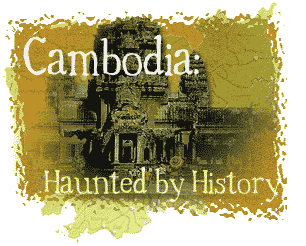
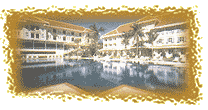 Raffles International specializes in renovating grand old hotels, the Raffles House in Singapore being most famous. The company has recently renovated two French colonialist hotels in Cambodia: The Hotel Le Royal in the capital Phnom Penh and Le Grand Hotel D'Angkor in Siem Reap, a small town near the ancient temples of the Angkor civilization. Unfortunately, almost nobody had been visiting Cambodia lately.
Raffles International specializes in renovating grand old hotels, the Raffles House in Singapore being most famous. The company has recently renovated two French colonialist hotels in Cambodia: The Hotel Le Royal in the capital Phnom Penh and Le Grand Hotel D'Angkor in Siem Reap, a small town near the ancient temples of the Angkor civilization. Unfortunately, almost nobody had been visiting Cambodia lately.
 My room at Le Royal was the Charles De Gaulle suite, real Persian rugs, wall to wall marble in the bathroom, and a cable television. I turned it on and watched the second "Ghostbusters" film. I flipped to CNBC and watched a weather report for all of Asia: cloudy in Lhasa, snow in Beijing and 95 degrees in Singapore.
My room at Le Royal was the Charles De Gaulle suite, real Persian rugs, wall to wall marble in the bathroom, and a cable television. I turned it on and watched the second "Ghostbusters" film. I flipped to CNBC and watched a weather report for all of Asia: cloudy in Lhasa, snow in Beijing and 95 degrees in Singapore.
 The security officer said he had pretty good information on current events around Cambodia as he was in telephone communication with representatives in all the out-lying areas. I asked him if he thought it was safe to travel around the country and he laughed and said only a fool would think so.
The security officer said he had pretty good information on current events around Cambodia as he was in telephone communication with representatives in all the out-lying areas. I asked him if he thought it was safe to travel around the country and he laughed and said only a fool would think so.
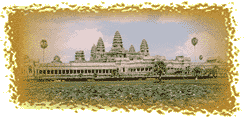 I rode home at 2 am and the streets were absolutely deserted. The security officer had said that this was a sign that something might be wrong, and I realized what was wrong was that I was lost. I rode in the direction I felt good about, and then I rode in some other directions I felt increasingly less good about. And then, finally, I saw it, all lit up and almost glowing from within, Hotel Le Royal, one of the finest hotels in one of the worst places in the world.
I rode home at 2 am and the streets were absolutely deserted. The security officer had said that this was a sign that something might be wrong, and I realized what was wrong was that I was lost. I rode in the direction I felt good about, and then I rode in some other directions I felt increasingly less good about. And then, finally, I saw it, all lit up and almost glowing from within, Hotel Le Royal, one of the finest hotels in one of the worst places in the world.
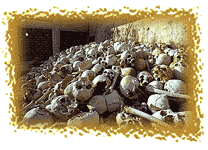
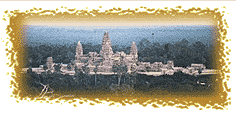 The temples were big and beautiful and frightening, built out of reddish-yellow sandstone and had the appearance of being engulfed in flames, a passion and exuberance like the Baroque. Built by a series of Hindu god-kings who ruled Cambodia from 800 to 1200 AD, their design and layout represents the fundamental cosmic and metaphysical conceptions that governed the ancient Cambodian world.
The temples were big and beautiful and frightening, built out of reddish-yellow sandstone and had the appearance of being engulfed in flames, a passion and exuberance like the Baroque. Built by a series of Hindu god-kings who ruled Cambodia from 800 to 1200 AD, their design and layout represents the fundamental cosmic and metaphysical conceptions that governed the ancient Cambodian world.